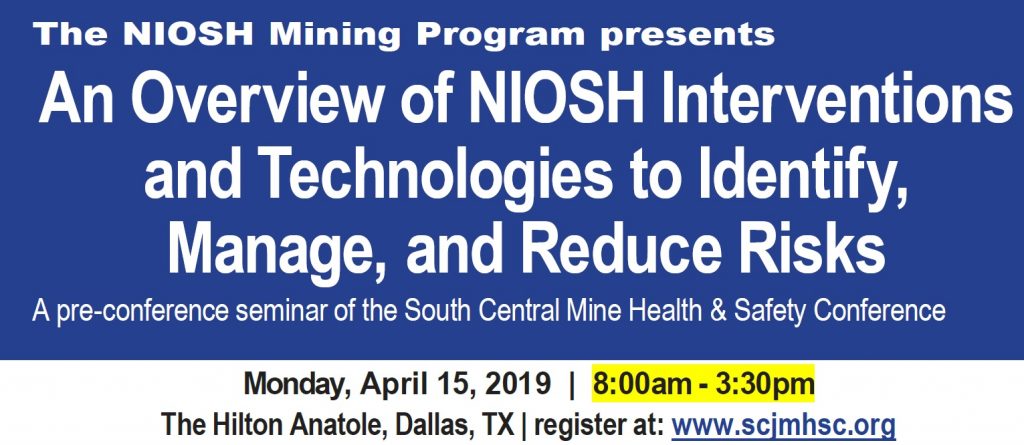
Hazard Recognition and Workplace Exams : Brianna Eiter, PhD*
The EXAMiner is a NIOSH-developed software tool that allows companies the opportunity to use our stock materials or upload their own pictures to create their own hazard recognition materials. This portion of the workshop will provide a tutorial on how to take panoramic pictures and upload them into the software. Participants will have time to use the software to identify hazards and discuss how this tool can be used to assist with workplace exams on their respective mine sites.
Engineering Controls to Reduce Health and Safety Risks Emily Haas, PhD*; John Sammarco, PhD*
EVADE is another NIOSH-developed software technology that affords companies the ability to identify exposure to various contaminants in real-time, coupled with the use of video exposure monitoring. Participants will have a chance to download, set-up and use the video exposure monitoring and EVADE software. This portion of the workshop will showcase specific case studies NIOSH has completed to identify respirable dust hazards and lighting glare that reduce visibility. As a result, a review of exposure to respirable silica dust and lighting glare will take place in order to present the interventions completed that have reduced these health and safety risks.
Emergency Management and Response: Cassandra Hoebbel, PhD*; John Sammarco, PhD*
A recent self-report survey of underground mineworkers revealed that a surprising number lack confidence in many of the critical self-escape competencies that are critical during an emergency. This portion of the workshop allows participants to take the self-report assessment, and preview self-escape competency profiles for leadership and rank and file miners. Along these lines, there is ongoing research to optimize visibility of escape way markers and a novel lighted lifeline to improve mine self-escape. The workshop will include the demonstration of LED lighting and a lighted lifeline.
Leadership Practices to Manage and Mitigate Risks: Emily Haas, PhD*
An Overview of NIOSH Interventions and Technologies to Identify
Pre-conference seminars are offered as optional activities for conference attendees. Seminar registration is separate from the regular conference fee, and covers the venue, materials. Registration: $75 (LIMITED Seating registrations must be in by April 1, 2019.)

Presenter Bios
Brianna Eiter, Ph.D. Dr. Eiter is a Research Behavioral Scientist working on the Mine Emergency and Organizational Systems Team at the National Institute for Occupational Safety and Health (NIOSH) Pittsburgh Mining Research Division (PMRD) located in Pittsburgh, Pennsylvania. In the six years that Brianna has worked at PMRD, she has been involved in research projects focusing on hazard recognition and risk perception, informational needs of the underground coal miner, and fatigue risk management for small surface mines. Brianna has over 15 years of experience in her research area of expertise which is human cognition and the use of eye-tracking to measure human behavior. Brianna graduated with a Bachelor’s degree from Lehigh University and then went to Binghamton University where she earned both her Master’s and Doctoral degrees in Cognitive Psychology.
Emily Haas, Ph.D. Dr. Haas is a Lead Research Behavioral Scientist on the Human Factors Branch at the National Institute for Occupational Safety and Health (NIOSH) Pittsburgh Mining Research Division (PMRD) located in Pittsburgh, Pennsylvania. Dr. Haas studies issues related to health, safety, and risk management in the mining industry. Leading research efforts with mineworkers and mine management across mines of various commodities, she has helped facilitate safer work behaviors and reduce barriers to sustaining those behaviors. Specifically, her research studies risk by way of integrating work practices around mine technologies including proximity detection systems, Helmet-CAM assessment technology, and continuous personal dust monitors. Dr. Haas has more than 25 papers published in public health, occupational safety, and mining journals. Emily has a PhD in Health Communication from Purdue University, Indiana, and an MA/BA from the University of Dayton, Ohio.
Cassandra Hoebbel, Ph.D. Dr. Hoebbel is a Research Behavioral Scientist for the National Institute for Occupational Safety and Health (NIOSH) Pittsburgh Mining Research Division (PMRD). As a member of the Mine Emergency and Organizational Systems team, Dr. Hoebbel’s research focuses on the characterization and improvement of the mine emergency escape system. Of specific interest to Cassandra is how mineworker self-escape competence might be improved through continuous performance assessment and remediation. Trained in psychology and school counseling, Cassandra received her B.A. (Psychology) from the State University College at Buffalo, her Ed.M. and her Ph.D. from the Graduate School of Education at the State University of New York at Buffalo.
John Sammarco, Ph.D. Dr. Sammarco is a Principal Research Engineer with the National Institute for Occupational Safety and Health. During his career, he has authored or co-authored more than 68 publications in mine safety research covering a wide variety of areas including machine safety, machine control systems, and sensor technologies. His early research concerned mining machine guidance and control for mining automation and he led the establishment of best practice safety recommendations for programmable electronic mining systems. His recent research areas concern the human factors of lighting and mine illumination to improve safety and miner self-escape. Dr. Sammarco has the following degrees: Ph.D. Computer Engineering, West Virginia University; M.S. Computer Engineering, National Technical University; M.S. Industrial Engineering, University of Pittsburgh; B.S. Electrical Engineering Technology, Pennsylvania State University.